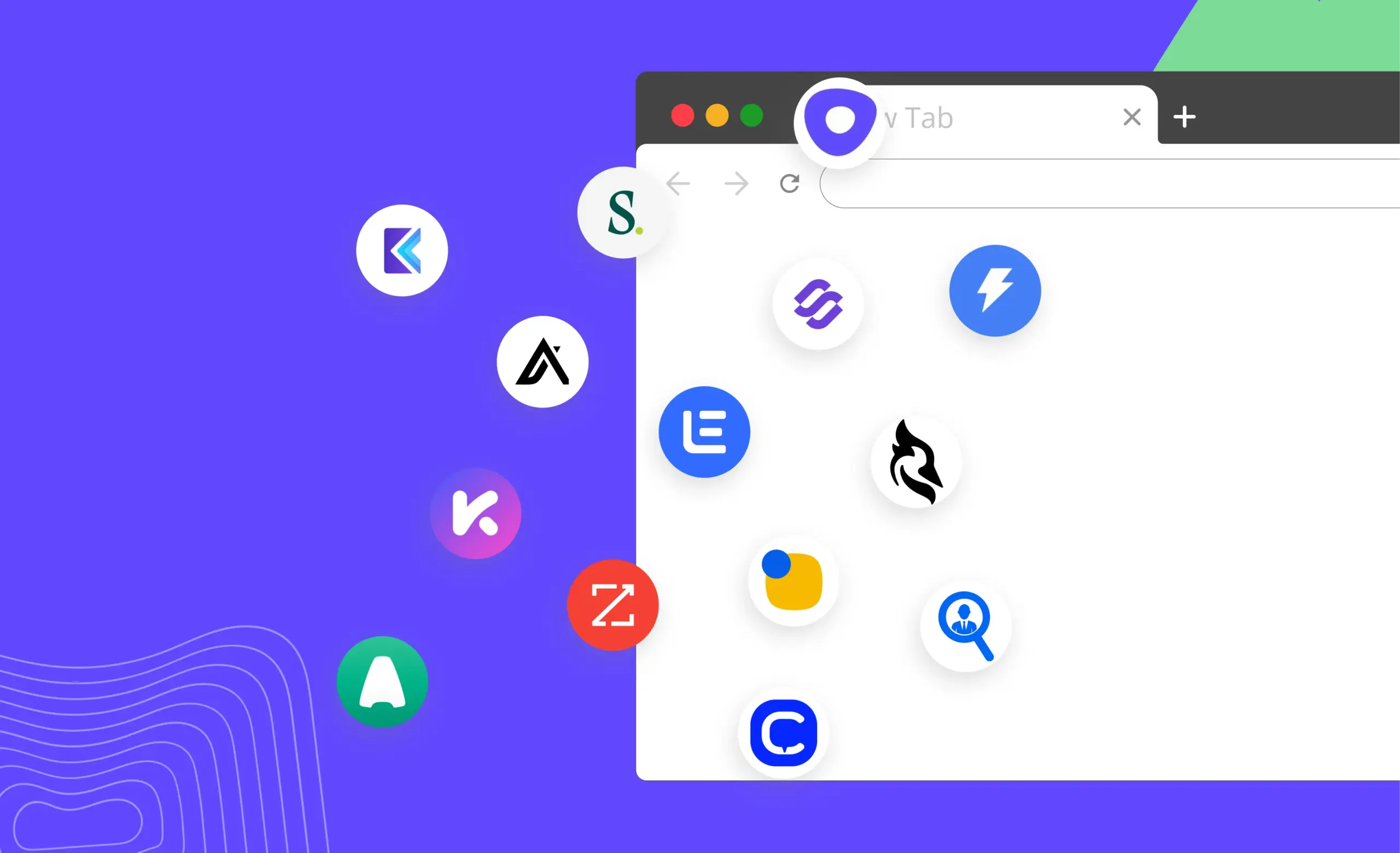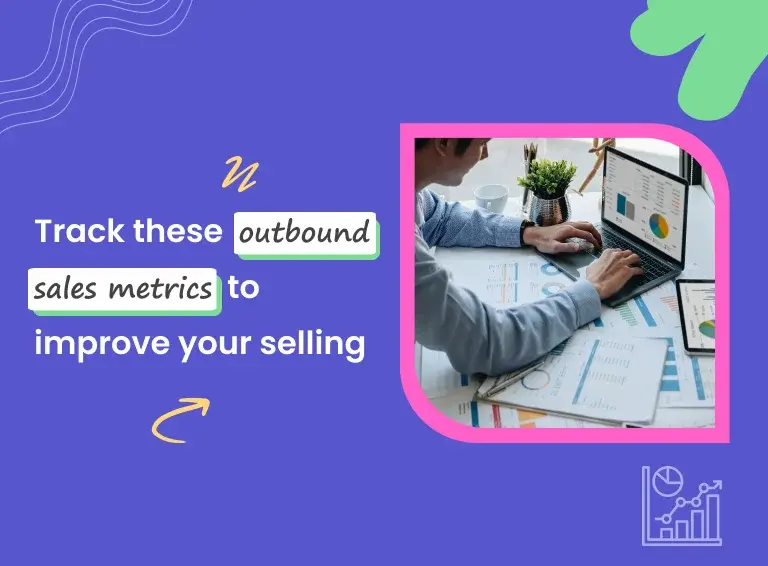Manual outbound processes drain productivity and stall growth, in today’s B2B sales landscape. Sales reps end up importing prospects from spreadsheets, juggling endless follow-ups, and updating engagement data by hand.
As lists grow, teams quickly discover it’s impossible to personalize outreach or track every touchpoint, making generic messaging and missed pipeline opportunities the norm.
The root problem? Most sales engagement platforms still force reps into non-pipeline activity:
Leads slip through the cracks due to inconsistent follow-up and manual logging.
Countless hours are lost to data entry and prospect research, instead of focusing on real conversations.
Reporting and analytics are fragmented across tools, hiding true pipeline progress and making forecasting unreliable.
Outreach feels impersonal and repetitive, so prospects tune out, replying less and less.
With traditional outbound workflows, stalled deals and unachieved quotas become a constant risk. Sales teams need a way to break free from these process-level, activity-level, and list-level bottlenecks, and finally spend all their time on what matters: building pipeline and closing deals.
So, First, How Do You Automate Outbound Sales?
Manual outbound sales routines, shaped by traditional sales engagement platforms, force reps into non-pipeline activity day after day.
- Prospects are manually imported from spreadsheets or CSVs into CRMs, often missing ICP scoring and leaving reps chasing unvetted accounts.
- Reps send batches of cold emails with generic templates to every account, failing to personalize outreach and deliver relevant messaging.
- Follow-ups are inconsistent, as reps get lost figuring out which template to send next, who to contact, and which prospects to prioritize, SDRs often give up after 2-3 touches.
- Updates to prospect engagement status, reporting, and analytics get fragmented between tools and manual logs, making pipeline visibility difficult and unreliable.
- Overdue tasks pile up, and reps spend just a fraction of their day actually building pipeline, most hours are consumed by list-building, research, enrollment, and admin activity.
Now, how can you automate that process?
All those non-pipeline activities: building lists, researching accounts, managing cadences, updating your CRM, and manually figuring out next steps, can now be automated. Teams stuck in the traditional model spend most of their day just trying to get organized, not actually building pipeline.
The real shift begins when you move away from standardized cadences, manual task-based work, and unvetted account lists built on outdated filters. Instead, focus only on tightly-vetted, ICP-scored accounts, and replace repetitive process-level and activity-level tasks with automation that lets SDRs approve, not do, every pipeline-building step.
By automating low-value admin and data entry, reps can finally spend their day on true sales activity: personalizing outreach, running live conversations, and moving good-fit deals through the pipeline. What exactly can you automate and with what kind of tools? We mention that below.
What Is an Outbound Sales Software?
This is the solution you are looking for.
Outbound sales software is designed to solve the non-pipeline activity problem that’s built into outdated sales engagement platforms and the “2020 outbound playbook”.
Rather than having reps waste hours building lists, researching accounts, drafting emails, managing cadences, and endlessly updating their CRM, modern outbound sales software shifts teams to a new model: pipeline-only activity. Here, AI agents and automation take over every process-level, activity-level, list-level, and channel-level task. That means reps are no longer ‘doers’ stuck in task-based work, but instead become ‘approvers’ who focus only on validated opportunities and high-impact conversations.
What does that look like in action?
AI agents build and score highly-targeted ICP lists, pull real-time contact data from multiple sources, draft tailored messages, automate follow-ups, manage all cadence actions, transcribe calls, and sync each touchpoint to your CRM. Every SDR receives a prioritized, vetted account plan, with guidance on who to contact, what to say, and when and where to engage.
With outbound sales software built for today’s playbook, you leave behind standardized, manual processes and move to a workflow that is truly personalized, automated, and engineered for pipeline growth.
Categories of Outbound Sales Software
1. AI-Powered Outbound Sales Software
1. Klenty
Klenty is an AI outbound sales software, uniquely designed to help SDRs focus on pipeline activity. Instead of reps spending hours on non-pipeline activities: manual list building, chasing the wrong accounts, account research, standardized cadence execution, and updating CRM, Klenty uses a team of 6+ AI agents to automate, orchestrate, and personalize every step of the outbound sales process.
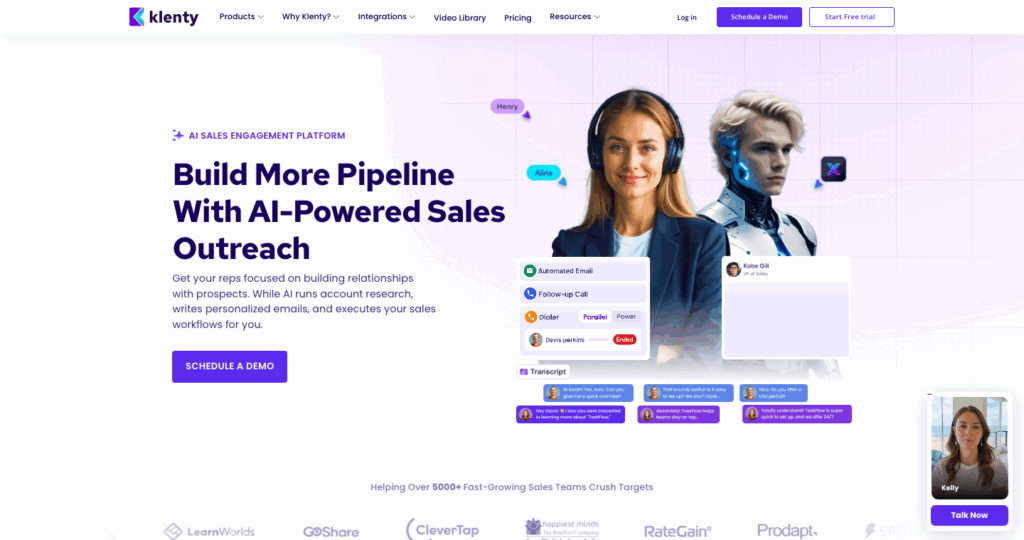
Features and Their Importance for Outbound Sales:
1. AI List Builder
The foundation of outbound success is targeting the right accounts. Ordinary platforms force reps to spend hours refining filters and end up with imperfect lists. Klenty’s AI List Builder lets reps build highly targeted ICP lists by typing prompts in plain English (“Find B2B enterprise SaaS companies hiring SDRs, expanding in APAC, using Salesforce”).
The AI scores each account and provides reasons, tapping into 700M+ contacts and enriching with valid emails/phones. This lets reps focus only on prospects with the highest fit and engagement potential, solving one of outbound’s biggest problems: bad data and wasted outreach.
2. Agentic Cadences
Most platforms push reps to follow standardized sequences and execute templated outreach. Klenty’s Agentic Cadence engine creates fully personalized multistep sales cadences, automatically writing emails, executing research in seconds, and customizing sequence steps for each prospect/account.
Reps simply review and approve AI output, combining AI-powered strategy with manual guardrails to ensure complete control. This means every account gets a unique engagement plan, maximizing response rate and reducing time wasted on repetitive work.
3. AI Playbooks
Traditional outbound sales software are built to execute the same set of activities for every prospect. Klenty’s AI Playbooks are dynamic, shifting leads into new cadences based on their behavior, so high-intent prospects get more attention from reps and unresponsive accounts get nurtured till their next buying cycle begins.
4. Personalization Suite
Outbound is only effective when emails and messages feel relevant. Klenty enables advanced personalization by merging manual tools (merge tags, liquid templates), visual tools (personalized images/videos), and AI-powered insights (LinkedIn posts, company news, tech stack).
Reps can choose the data point, and AI drafts a true 1:1 message. This makes every email authentically relevant, driving higher reply and meeting rates.
5. Email Deliverability Suite
Klenty provides a full-stack email deliverability suite to ensure your emails don’t end up in spam.
It handles everything from the initial setup to optimization:
Email deliverability is improved using features like:
- Done-for-you domain and mailbox setup, including DKIF, DMARC, and SPF
- Auto-email warmup and Auto-inbox rotation
- Centralized domain-level and mailbox-level reporting
- Periodic optimization and on-demand deliverability tests
- Email throttling to mimic human-like send patterns
- Custom tracking domains and spam safeguard checks
6. Native CRM Integrations
Klenty’s deep, two-way integrations with Salesforce, HubSpot, Pipedrive, and Zoho mean every engagement is logged, triggers fire instantly, and reps focus on pipeline-generating activities without admin work.
Klenty is the best outbound sales software because it automates every manual task, lets teams build highly vetted ICP accounts, and gives SDRs full control with dynamic, AI-powered cadences.
Instead of routine admin, reps focus 100% on building pipeline while AI Agents handle the rest, making Klenty the go-to choice for sales teams who want SDRs to focus on high-impact activity across multiple channels.
| Solution | Key Feature | Capabilities | Best for |
|---|---|---|---|
| Klenty | AI List Builder, Agentic Cadences, AI Playbooks, AI Agents, CRM integration | ICP-scored lists, custom playbooks, automate research, outreach, follow-ups, CRM sync, pipeline-only focus | High-velocity outbound teams |
| Outreach | Multi-channel Sequences | Advanced email, call, social outreach, AI-driven analytics | Large sales orgs needing deep analytics and workflow customization |
| Salesloft | Modern Revenue Workspace | Cadence automation, pipeline tracking, forecasting, conversation intelligence | Enterprise teams needing robust automation and compliance |
| Reply.io | Omni-channel Sales Automation | Multi-channel sequences, AI personalization, deliverability | SMB/enterprise teams needing quick setup, strong deliverability |
| Apollo.io | Sales Intelligence & Email Sequencing | Enriched contact database, email automation, advanced reporting | Teams requiring integrated data and outreach |
| Lemlist | Personalized Outreach | Email campaigns, image/video personalization | Agencies/SMBs wanting visual, branded outreach |
| Woodpecker | AI Email Assistant | Condition triggers, GDPR compliance, multi-channel support | SMBs/agencies seeking affordable, data-compliant outreach |
| Instantly | Unlimited Email Sending | High-volume campaigns, CRM workflows, inbox warm-up | Agencies and high-volume teams |
| Myphoner | Power Dialer Workflow | Fast call campaigns, lead tracking, team management | Small agencies or freelancers focused on calling |
| Aircall | VoIP Integration | CRM/helpdesk sync, call analytics, live coaching | Distributed sales and support teams |
| CloudTalk | Global Call Automation | IVR, call routing, analytics, CRM integrations | International outbound/inbound call teams |
| Close CRM | Multi-channel CRM | Integrated dialer, pipeline management, flexible reporting | Startups needing unified sales communication and pipeline |
| LinkedIn Navigator | Advanced Prospecting | Lead recommendations, CRM sync, InMail, activity alerts | B2B teams focusing on LinkedIn/social selling |
| Kaspr | LinkedIn Data Enrichment | Chrome extension, automated email outreach | Teams targeting LinkedIn lead lists at scale |
| Meet Alfred | Social Selling Automation | Email, Twitter sequencer, analytics | Agencies/teams needing multi-channel social selling |
| ZoomInfo | Data Intelligence Platform | Intent signals, advanced segmentation, automatic workflows | Large sales teams needing real-time intent data |
| Cognism | GDPR-Compliant Global Data | AI enrichment, dialer, Chrome extension, live triggers | International data-driven prospecting teams |
| Seamless.AI | AI Lead Search & Validation | Email, phone enrichment, Chrome extension, smart filters | Teams wanting real-time searchable data |
| Lusha | Contact Enrichment | Fast email export, bulk CRM sync, compliance | Sales teams needing bulk enrichment, privacy control |
| GetAccept | Digital Sales Room | Deal room, contract signing, analytics, personalized videos | Teams running collaborative, multi-stakeholder deals |
| Dock | Collaborative Deal Workspace | Action plans, doc sharing, analytics, CRM integration | B2B teams needing seamless buyer-seller collaboration |
2. Outbound Sales Software for Multi-Channel Outreach
2. Outreach
G2 Rating: 4.3/5
Outreach is designed for revenue teams to unify outbound communication across email, phone, and social channels. It centralizes every touchpoint, automates manual work, and harnesses advanced analytics and forecasting to help teams prospect more effectively and scale conversion rates.
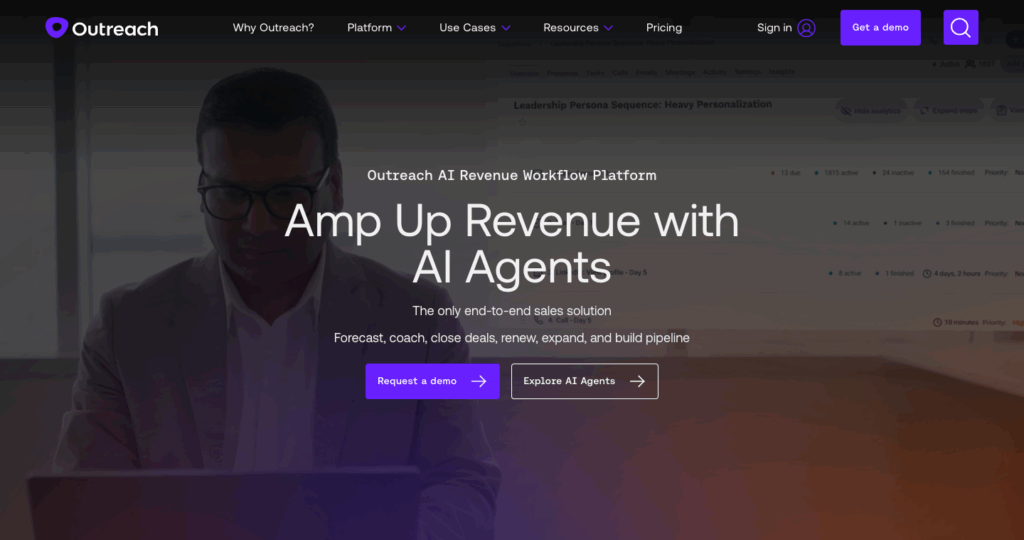
Key Features:
- Multi-channel outreach sequencing and automation
- AI-driven forecasting and conversation analytics
- Deep CRM/task/workflow integration
- Team collaboration with shared templates and reporting
Pros:
- Highly customizable for large teams
- Powerful analytics and AI-guided insights
- Robust integrations
Cons:
- High pricing for startups
- Steep learning curve with advanced modules.
Pricing:
Starts at $100/user/month; enterprise packages typically $20k+/year
3. Salesloft
G2 Rating: 4.5/5
Salesloft offers a workspace for automating cadence management, pipeline tracking, communications, and analytics across calls, emails, and social touches. It empowers teams to scale prospecting, manage pipeline efficiently, and improve outcomes with best-in-class reporting, coaching, and secure integrations.
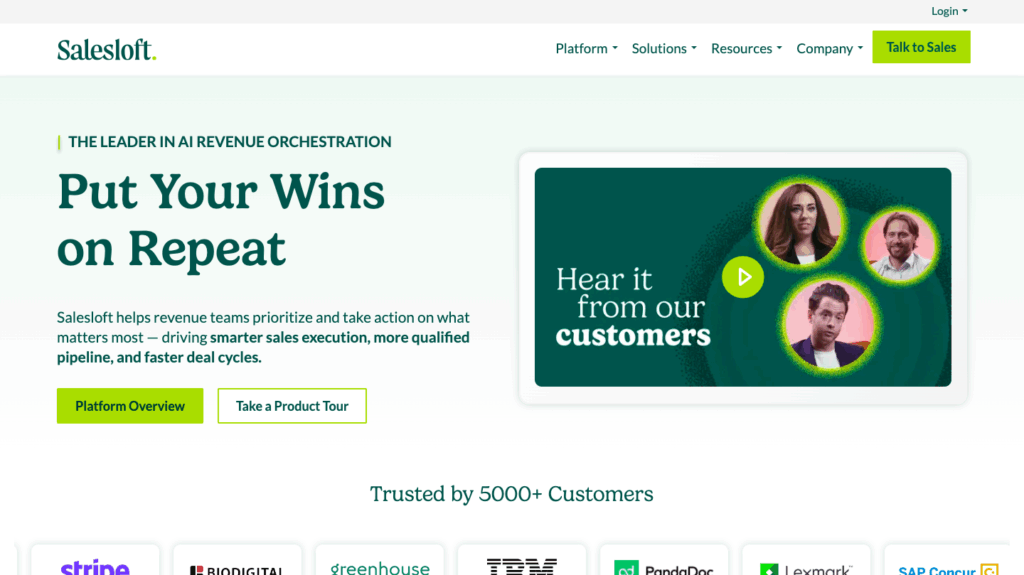
Key Features:
- Multi-channel cadence automation
- Pipeline management and forecasting analytics
- Conversation intelligence, coaching, and call recording
- Enterprise-grade security and CRM integration
Pros:
- Deep automation for high-touch selling
- Robust analytics and management features
- Secure data governance
Cons:
- Custom pricing, less suited for small teams
- Syncing with large CRMs can require attention.
Pricing:
Custom pricing
4. Reply.io
G2 Rating: 4.6/5
Reply.io is a multi-channel engagement and automation platform that enables scalable email, phone, and SMS campaigns with AI personalization. It offers powerful sequencing tools, deliverability support, and detailed analytics, empowering teams to ramp up outreach and track performance efficiently.
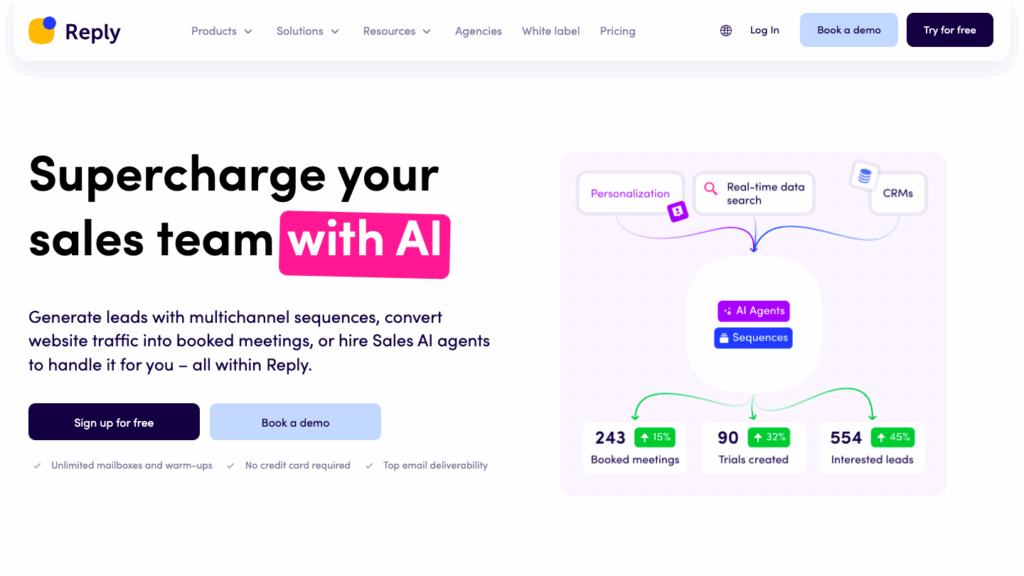
Key Features:
- Multichannel campaigns and task orchestration
- AI-powered personalization and automated reply detection
- Email validation/deliverability tools
- Chrome extension, CRM integration, analytics suite
Pros:
- User-friendly for both small and large teams
- Strong deliverability and campaign analytics
- Quick deployment
Cons:
- Costs can grow with additional mailboxes
- Occasional minor technical issues
Pricing:
From $49/user/month starter, $99/user/month multichannel, AI SDR from $500/mo.
5. Salesforge
G2 Rating: 4.8/5
Salesforge offers an outbound sales software blending AI-driven deliverability, mailbox management, bulk sending, and automated lead verification. Designed for agencies and high-volume teams, it combines advanced outreach capabilities with real-time campaign reporting and process optimization.
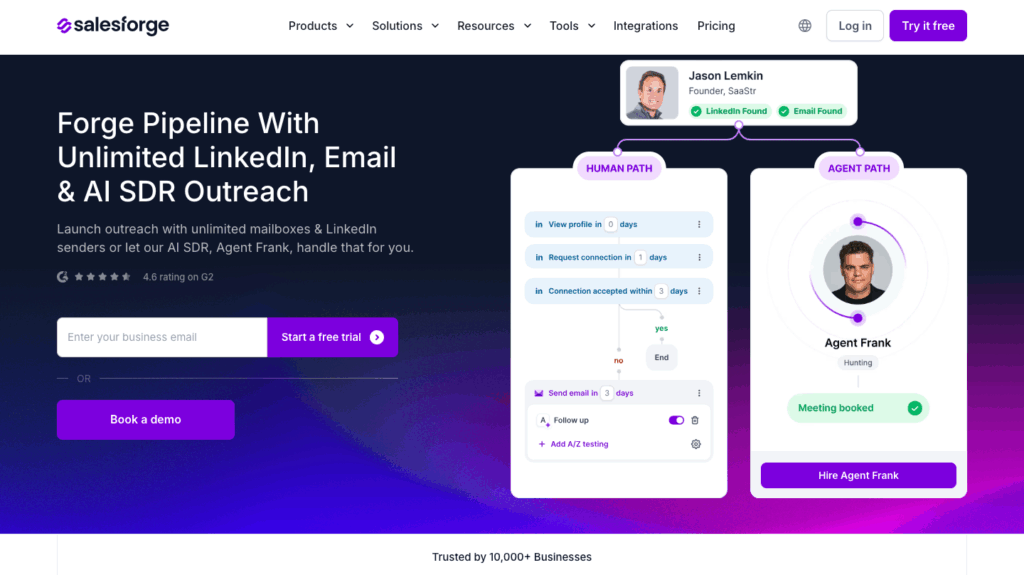
Key Features:
- AI mailbox/inbox management and warm-up
- Bulk campaigns with smart sender logic
- Automated lead validation and enrichment
- Workflow builder, analytics, Chrome extension
Pros:
- Good for high-volume agency outbound
- Real-time deliverability controls
- Easy campaign setup and dashboard usability
Cons:
- Too complex for small/new teams
- Support is primarily online chat/email
Pricing:
Free trial (50,000 emails); Pro plan $40/mo for 5,000 emails and full feature set
3. Outbound Sales Software for Email Sequencing & Automation
6. Apollo.io
G2 Rating: 4.7/5
Apollo.io combines robust contact data, powerful email sequencing, and analytics into one integrated workspace. Apollo helps teams discover prospects, automate targeted outreach, and manage contact enrichment at scale, all with built-in reporting and Chrome extension tools that make prospecting faster and smarter.
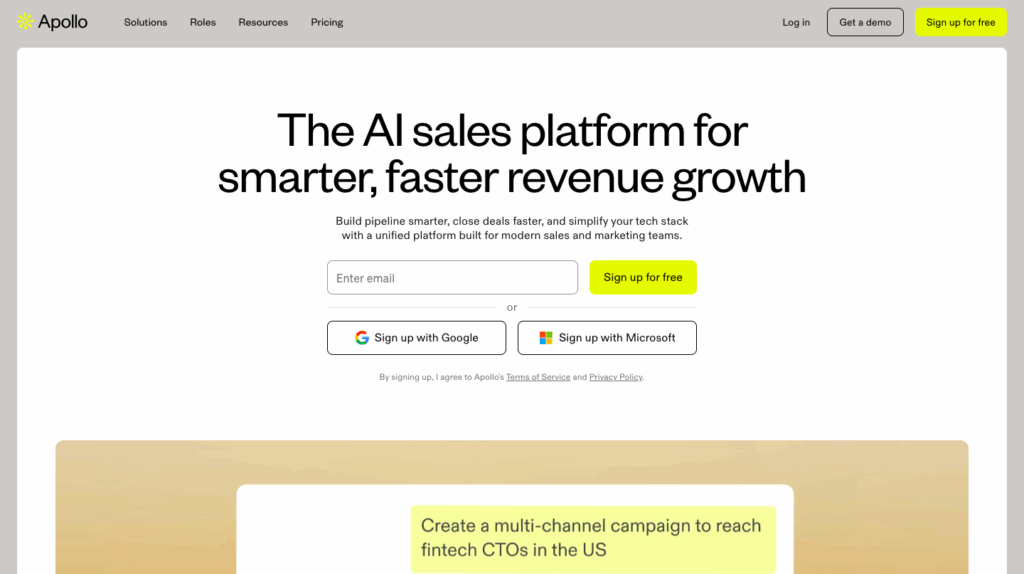
Key Features:
- 250M+ global contact database and enrichment tools
- Automated email sequencing and follow-up workflows
- Advanced analytics and pipeline reporting
- Chrome extension for web prospecting
Pros:
- Free tier makes testing easy for small teams
- Rich reporting and high-quality contact enrichment
Cons:
- Some feature limits on entry-level plans
- Email warm-up and advanced automation cost extra
Pricing:
Free plan available; paid plans start at $49/user/month (Basic) to $149/user/month
7. Lemlist
G2 Rating: 4.4/5
Lemlist specializes in personalized cold outreach, especially for SMBs, with automation for email campaigns, dynamic images and videos, multi-step follow-ups, and deliverability management. Teams use Lemlist to boost engagement by merging scalable message delivery with visual personalization and A/B testing.
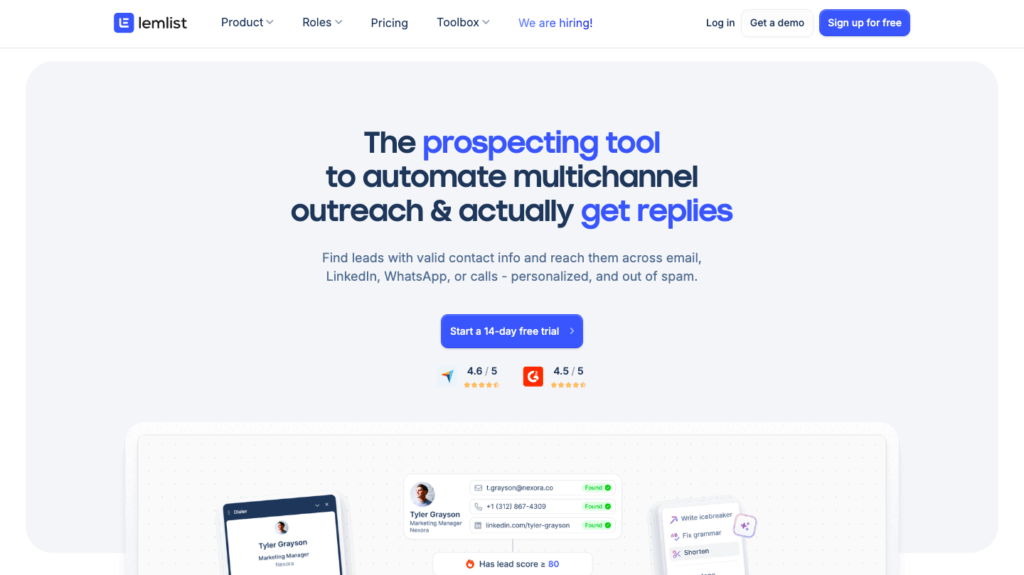
Key Features:
- Personalized email campaign automation
- Dynamic images and video generation for emails
- Sequence builder with multichannel workflows
- Deliverability analytics and warm-up solution
Pros:
- User-friendly interface and rapid campaign setup
- Unique image/video personalization stands out
- Affordable for small or growing agencies
Cons:
- Limited calling capability (focus is email/social)
- Some learning curve for advanced sequences
Pricing:
Starts at $39/user/month (Starter), Pro at $99/user/month, Enterprise at $200+/user/month
8. Woodpecker
G2 Rating: 4.3/5
Woodpecker is a cold outreach automation platform designed for B2B agencies focused on email campaign performance, integrated list management, and compliance. The platform offers AI-powered assistant tools, multi-channel workflows, inbox rotation, and GDPR-ready integrations that help teams grow response rates and expand outreach.

Key Features:
- AI email assistant for rapid campaign creation
- Multi-channel campaign builder (email/call)
- Condition-based automation and inbox rotation
- GDPR-compliance and integrations (HubSpot, Pipedrive, Zapier)
Pros:
- Efficient for list-based and agency workflows
- GDPR compliance built in for data safety
- Affordable starting price for small teams
Cons:
- Limited features in basic plan; advanced options cost more
- Less flexible for bulk LinkedIn outreach
Pricing:
Starts at $29/month (cold email plan); agency plans begin at $56/month
9. Instantly
G2 Rating: 4.8/5
Instantly is built for scalable cold email campaigns, offering unlimited sender inboxes, automated warm-up, built-in lead databases, and direct CRM management. The platform is popular among high-volume agencies, enabling users to send and track hundreds of thousands of emails monthly while monitoring deliverability and campaign metrics in real time.

Key Features:
- Unlimited inbox management and automated warm-up
- Built-in lead database and CRM workflows
- High-volume sending (up to 500k emails/month)
- Deliverability testing and analytics
Pros:
- Designed for high-volume cold email prospecting
- CRM and inbox integration for workflow control
- Pricing scales with sending volume
Cons:
- Basic plan has limits on campaign features
- Integrations are still growing compared to older platforms
Pricing:
Starts at $37/month (Growth), $97/month (Hypergrowth), and advanced plans are available.
4. Outbound Sales Software for Cold Calling & Dialers
G2 Rating: 4.7/5
10. Myphoner
Myphoner is a lightweight power dialer and lead tracking CRM designed for simple outbound calling campaigns. It combines call management, follow-up scheduling, team oversight, and workflow automation to make cold calling more efficient and trackable for individuals or small agencies.
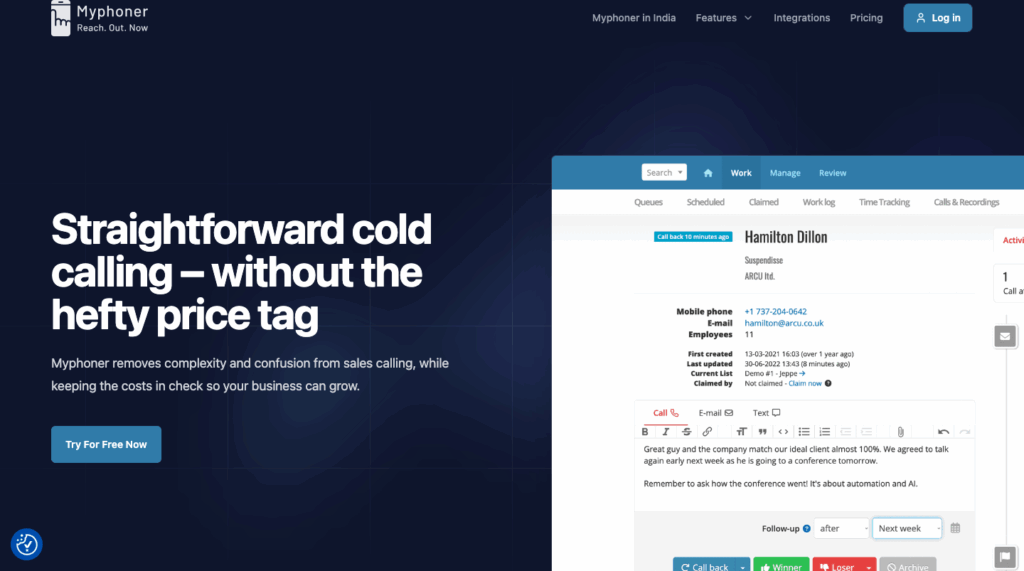
Key Features:
- Power dialer for fast outbound calling
- Lead and call tracking with follow-up reminders
- Campaign management for teams and freelancers
- Custom queue and reporting dashboard
Pros:
- Very affordable for startups and freelancers
- Intuitive workflow setup and call tracking
- Scalable for small agency needs
Cons:
- Limited integrations with enterprise CRMs
- Focused on voice, less suited for multi-channel prospecting
Pricing:
Starts at $19/month (Basic), $29/month (Plus), and $49/month (Premium).
11. Aircall
G2 Rating: 4.3/5
Aircall is a cloud-based VoIP phone system and call center software built for outbound sales teams. It offers seamless CRM and helpdesk integrations, real-time analytics, call routing and recording, plus power dialer and live coaching tools that support distributed teams and scaling call campaigns.

Key Features:
- Native CRM and helpdesk integrations
- Call routing, analytics, and real-time dashboards
- Power dialer, call recording, and multi-device support
- Live agent coaching and monitoring
Pros:
- Easy integration across sales and support tools
- Dashboard tracks key agent and call metrics
- Ideal for remote and distributed teams
Cons:
- Per-user pricing adds up for large teams
- Some users report call-quality or sync issues
Pricing:
Essentials plan starts at $30/user/month; Professional plan at $50/user/month.
12. CloudTalk
G2 Rating: 4.5/5
CloudTalk is a modern cloud-based call center platform designed for both outbound and inbound teams. It provides global calling capabilities, workflow automation, analytics, and IVR—along with a powerful dashboard and CRM integrations for seamless management.
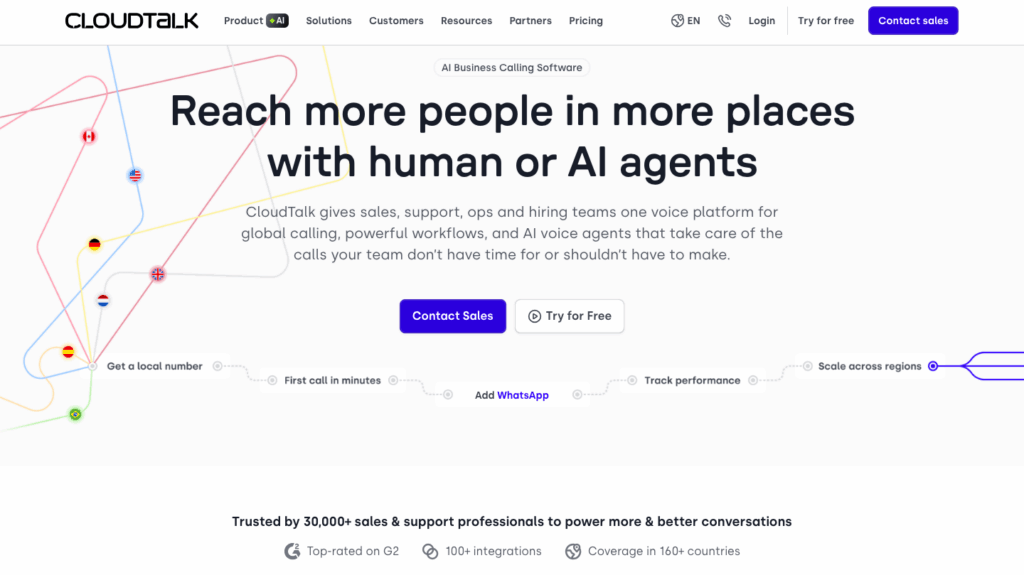
Key Features:
- Global and local outbound numbers
- IVR, call routing, and real-time analytics
- Call recording and monitoring dashboard
- Integrations with HubSpot, Salesforce, and other CRMs
Pros:
- Easy to use for global and local calling
- Strong analytics and dashboard features
- Scales efficiently for both inbound and outbound campaigns
Cons:
- Depends on internet quality and call volume
- Advanced features are available only on higher-tier plans
Pricing:
Starter plan begins at $25/user/month; Professional and custom plans are also available.
13. Close CRM
G2 Rating: 4.6/5
Close CRM combines CRM workflows with built-in calling, SMS, and email management to deliver an all-in-one sales automation platform. With an integrated dialer, pipeline and deal management, robust reporting, and sync with major sales tools, Close enables streamlined multi-channel outreach from a single workspace.
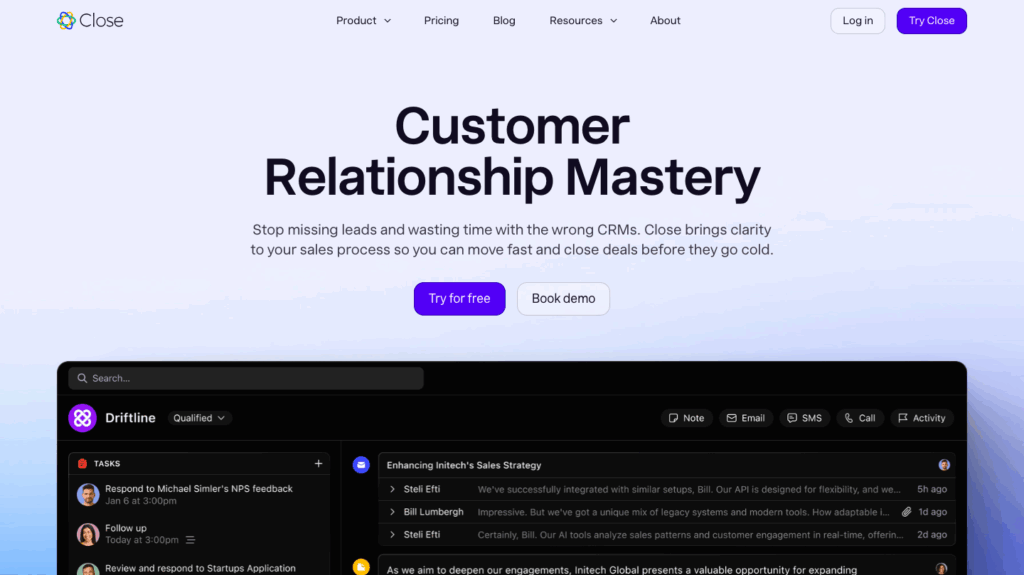
Key Features:
- Built-in power dialer and SMS automation
- Email and pipeline management dashboard
- Two-way email sync and templated responses
- Customizable reporting and workflow integrations
Pros:
- Simplifies multi-channel management in one tool
- Flexible pipeline and dashboard customizations
- Reliable integrations with popular sales tools
Cons:
- Higher pricing for small teams and startups
- Some feature complexity for new users
Pricing:
Startup plan starts at $99/user/month; Professional plan at $139/user/month.
5. Outbound Sales Software for Social Selling
14. LinkedIn Sales Navigator
G2 Rating: 4.3/5
LinkedIn Sales Navigator is LinkedIn’s flagship B2B prospecting platform, offering advanced search, lead recommendations, CRM sync, and team collaboration to help sales professionals find and engage buyers at scale. Custom lead lists, alerts, and InMail features enhance the precision and reach of outbound social selling.
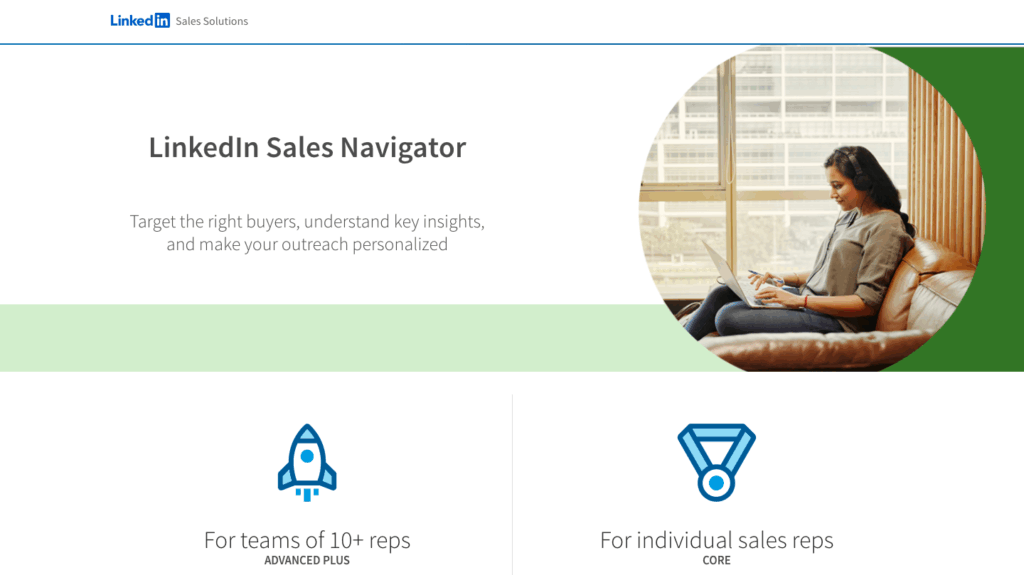
Key Features:
- Advanced search, lead recommendations, and CRM sync
- Team collaboration via TeamLink
- Real-time notifications and buyer activity insights
- Custom lead lists and InMail messaging
Pros:
- Access to vast, up-to-date professional data
- Direct integration with major CRMs
- Precise search filters simplify prospecting
Cons:
- Premium pricing for full feature access
- Limited multi-channel outreach (focuses on LinkedIn)
Pricing:
Starts at $99.99/user/month (Core); Advanced and Team plans are also available.
15. Kaspr
G2 Rating: 4.5/5
Kaspr is a social prospecting and automation tool that provides users with direct contact data enrichment, bulk list building, CRM integration, and automated outreach. It’s designed to turn web-based searches into actionable prospect lists with single-click exports.
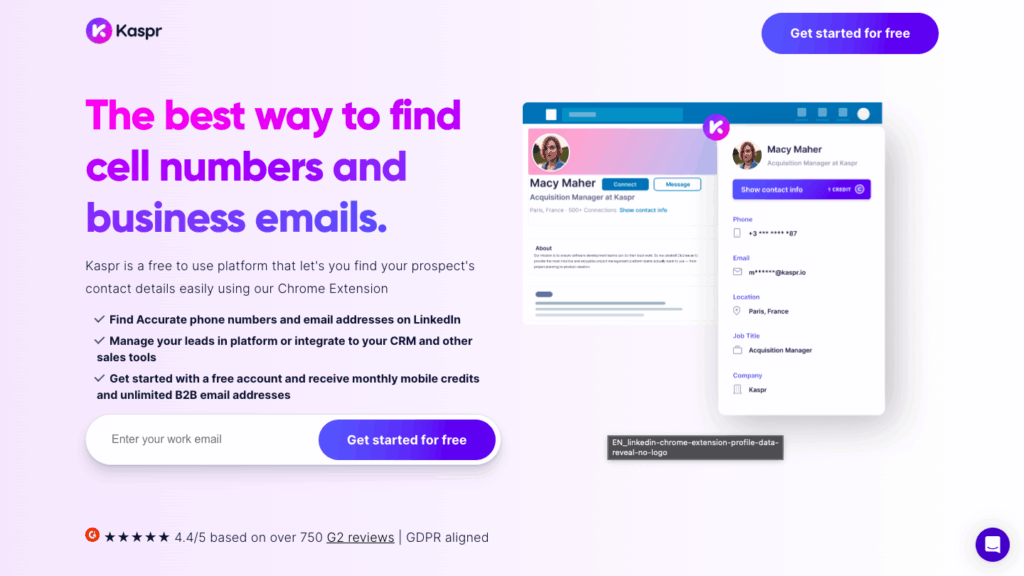
Key Features:
- Chrome extension for data scraping and enrichment
- Automated outreach via messenger platforms and email
- CRM integrations for instant contact export
- Contact data validation and analytics dashboard
Pros:
- Great for hyper-targeted lead building
- Simple bulk export to email and CRM
- Built-in data enrichment and validation
Cons:
- Focuses on web and social channels, with fewer phone/email features
- Higher-volume plans increase overall pricing
Pricing:
Starts at $49/user/month; custom high-volume plans are also available.
16. Meet Alfred
G2 Rating: 4.2/5
Meet Alfred automates multi-channel campaigns across LinkedIn, email, and Twitter for social selling, prospecting, and engagement. It provides personalized invites, multi-step workflows, and detailed analytics—allowing teams to track and optimize all outreach activities from a single dashboard.
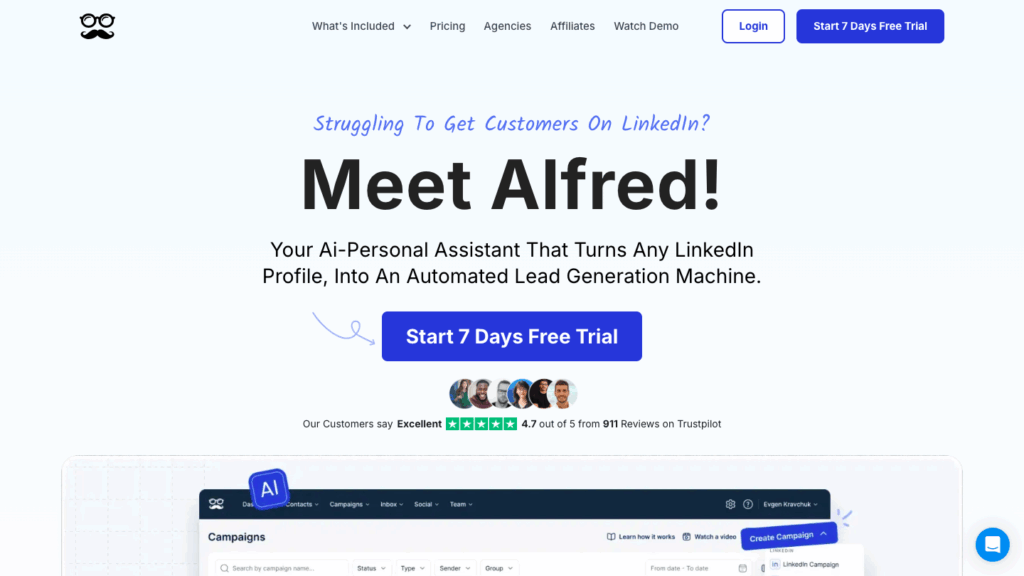
Key Features:
- Multi-channel campaign builder (LinkedIn, email, Twitter)
- Advanced personalization and invite sequencing
- Team dashboard for multi-user collaboration
- Analytics and reporting on outreach performance
Pros:
- Flexible for social and email automation
- Personalization boosts engagement rates
- Easy to scale for agency models
Cons:
- Fewer integrations compared to larger platforms
- Pricing scales quickly for large teams
Pricing:
Starts at $39/month (Solo); higher-tier plans available for agencies and teams.
6. Outbound Sales Software for Prospecting & Data Intelligence
17. ZoomInfo SalesOS
G2 Rating: 4.4/5
ZoomInfo SalesOS is a B2B data intelligence platform that combines a massive verified contact database, buyer intent signals, pipeline workflow automation, and CRM integrations. Its advanced search filters and real-time enrichment make it ideal for large prospecting teams that require detailed segmentation and outreach tracking.
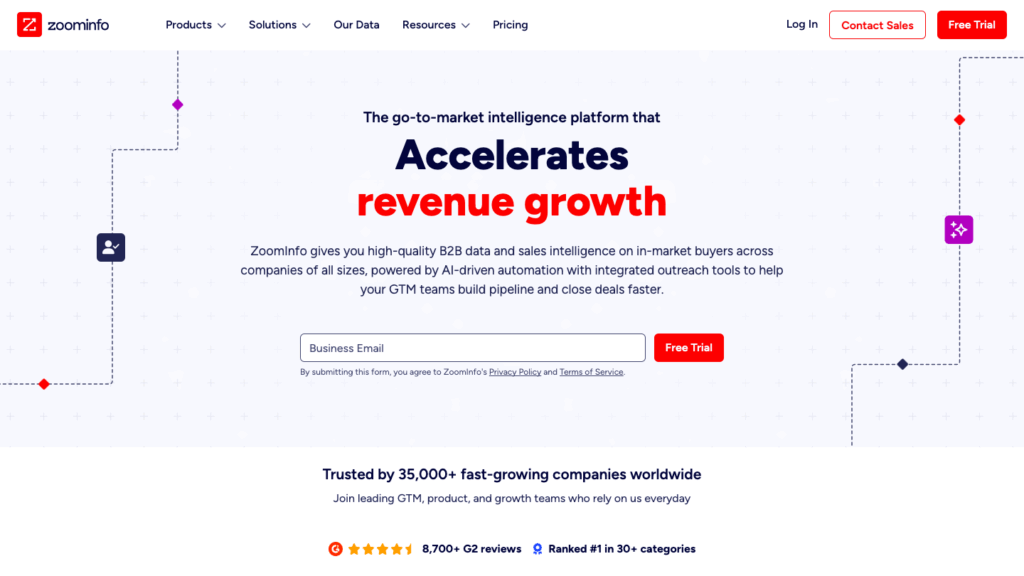
Key Features:
- 260M+ verified contacts with real-time intent signals
- Buyer intent alerts and automated workflows
- Chrome extension and CRM integration
- Advanced segmentation and analytics
Pros:
- Unmatched breadth of verified contacts
- Real-time updates and workflow automation
- Powerful prospect segmentation capabilities
Cons:
- Custom pricing is higher for wide access
- Learning curve for advanced segmentation features
Pricing:
Custom quote based on contacts, seats, and selected features.
18. Cognism
G2 Rating: 4.7/5
Cognism delivers global, GDPR-compliant contact data, enrichment, and lead triggers for B2B outbound sales. The platform’s advanced filters and AI-driven scoring help identify the best-fit prospects, while workflow automations keep teams focused on qualified conversion opportunities.
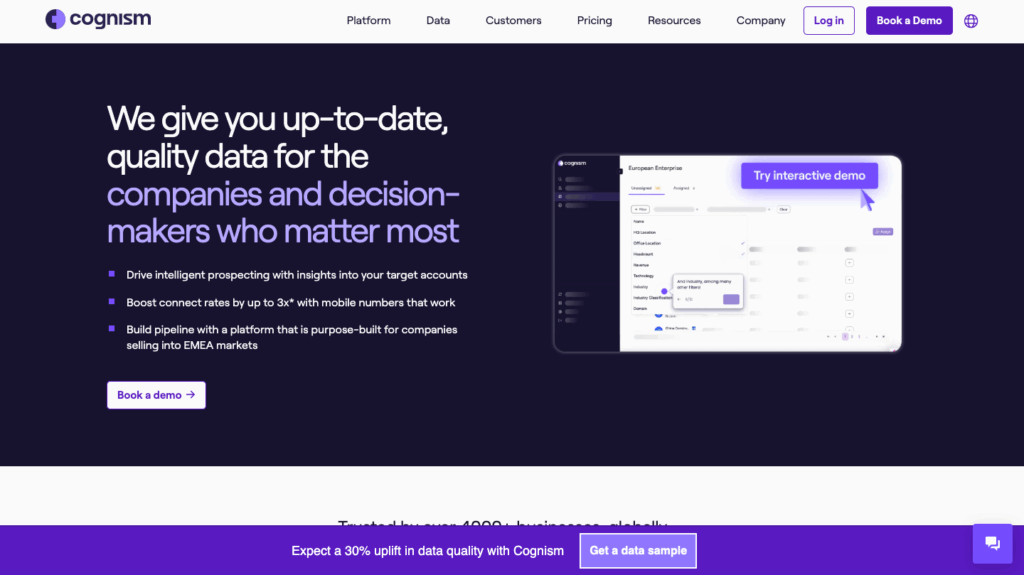
Key Features:
- 400M+ global contact profiles
- GDPR-compliant data and AI-powered enrichment
- Chrome extension for instant prospecting
- Built-in cold calling and dialer tools
Pros:
- Trusted source for verified, compliant prospect data
- Smart lead filtering and triggers improve conversions
- Excellent global and regional coverage
Cons:
- Custom pricing can be expensive with full access
- Limited depth for highly niche target markets
Pricing:
Custom pricing based on data volume and seat count.
19. Seamless.AI
G2 Rating: 4.3/5
Seamless.AI is an AI-driven search and data validation engine built for B2B sales teams. It offers real-time enrichment, intent signals, and verified contact discovery—helping teams build accurate, high-converting prospect lists with ease.

Key Features:
- AI search for verified emails and direct dials
- List building and smart filtering options
- CRM push and data validation workflows
- Chrome extension for quick web research
Pros:
- AI-driven contact validation ensures data quality
- Streamlines outreach with real-time enrichment
- Flexible solution for both agencies and enterprise teams
Cons:
- Advanced features may require higher-tier plans
- Bulk workflow automation is still evolving
Pricing:
Starts at $147/user/month (Basic); Pro and Enterprise plans scale with feature requirements.
20. Lusha
G2 Rating: 4.3/5
Lusha is a contact enrichment and prospecting platform that delivers verified email and phone information for web, CRM integrations, and bulk exporting. With built-in compliance and security, it enables trusted and efficient B2B prospecting for sales teams.
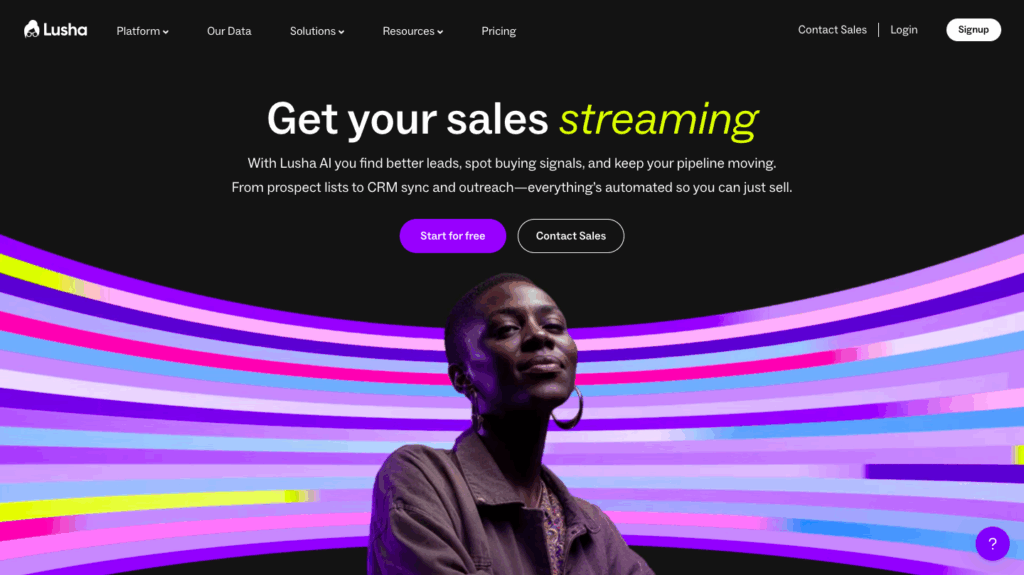
Key Features:
- Chrome extension for LinkedIn enrichment
- GDPR compliance and CRM synchronization
- Bulk export, team dashboard, and analytics
- Contact validation and privacy controls
Pros:
- Fast enrichment and seamless integration workflow
- Reliable for quick LinkedIn and email exports
- Strong privacy and compliance features
Cons:
- Usage limits on lower-tier plans
- Focused on enrichment, with fewer engagement features
Pricing:
Pro plan starts at $29/month; Premium plan at $51/month.
7. Outbound Sales Software for Digital Sales Rooms & Deal Collaboration
21. GetAccept
G2 Rating: 4.7/5
GetAccept is an end-to-end digital sales room platform designed to streamline deal management and boost buyer engagement. It offers contract workflow automation, personalized buyer experiences, real-time deal tracking, e-signatures, and deep CRM integrations—making it ideal for secure, collaborative deal execution and faster closures.

Key Features:
- Digital deal rooms and e-signature workflows
- Personalized video messaging capabilities
- Real-time analytics and timeline insights
- CRM and document management integrations
Pros:
- Excellent for high-value, collaborative sales processes
- Personalization enhances buyer engagement
- Robust contract and workflow automation features
Cons:
- Pricing increases significantly for enterprise deployments
- Onboarding can take longer for large teams
Pricing:
Starts at $49/user/month; custom pricing available for enterprise plans.
22. Dock
G2 Rating: 4.7/5
Dock is a deal room and collaboration platform that centralizes project assets, buyer-seller conversations, analytics, and e-signature workflows into a single workspace. It simplifies document sharing, project timelines, and mutual action plans—making deal management more transparent and efficient.
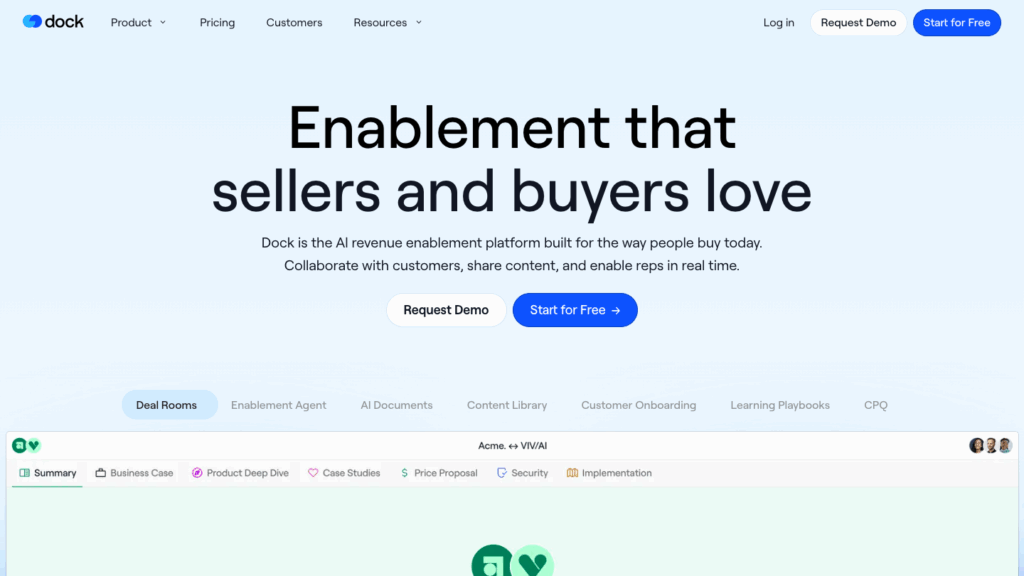
Key Features:
- Deal portals and collaborative workspaces
- Mutual action plans and document sharing
- Live analytics and buyer engagement insights
- CRM integration and workflow automation
Pros:
- Excellent dashboard and project visibility
- Smooth collaboration among all deal stakeholders
- Simplified analytics for quick performance reporting
Cons:
- Pricing can increase for teams with many users
- Some features require custom setup to match workflows
Pricing:
Starts at $75/user/month; Pro and custom plans are also available.
Conclusion
Ready to level up your outbound game?
You can finally spend less time chasing spreadsheets and more time building real conversations. By choosing the right tools, you empower your team to connect, engage, and close at record speed, with AI and automation on your side.
Outbound sales software is the solution that transforms how you win new business. You get hours back, leads never slip through, and every prospect gets a personal touch.
With Klenty’s outbound sales software, you get an outbound engine that builds perfect ICP lists, automates every sales cadence, and puts you in command of every high-impact conversation.
Imagine skipping manual admin and focusing only on prospects who actually convert. It’s time to move beyond busywork and become the team that hits quota consistently. Experience the difference Klenty makes. Start building your best-ever pipeline today!
Book a Demo.
